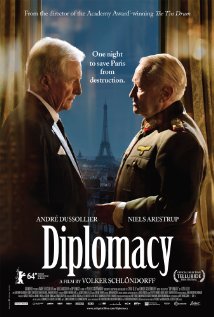|
Our contestant this week is Nicholas Gurwitch, of Rochester, New York. The hidden song should be extremely guessable, and the composer style will likely come down pretty clearly to two possibilities. But why this is such a particularly interesting Puzzler to listen to is that after the resolution, pianist Bruce Adolphe goes into a very long explanation of octotonic scales and and describes in fascinating detail how this particular piece came about.
0 Comments
Just to make clear for those semi-curious, it is only by total, unadulterated accident that my two postings today had to do with Hitler.
The good news is that in one, his orders were ignored -- and in the other, he was removed from the grocery shelves. On Sunday, I went to see a French film called, Diplomacy. It’s from on a stage play, that’s in turn based on a true story. (As was reminded to me by Greg Van Buskirk, it's the subject matter of the best-selling book and film Is Paris Burning? That was made in 1966, with an all-star star ensemble cast, this is completely intimate and deals almost exclusively with the two people at the direct center of the situation.) Near the end of World War II, Hitler gave an order that bombs be secreted throughout Paris -- especially under its greatest monuments -- so that the entire city would be blown up if the Allies ever arrived to free the city. And not just the city would be destroyed, but probably 1.5 million people. The film is about the Swedish diplomat Raoul Nordling who makes his way to the German military governor General von Choltitz prepared to give the order, as the Allies are on the outskirts of the city, about to entire, and his last-minute efforts to convince the general not to go through with the devastation. (I don’t want to give away whether the city is blown up or not…) It’s quite wonderful – and surprisingly taut, given that everyone watching knows what happens. But it’s the how and the personalities that pulls it all together, with terrific writing, very smart and crisp. It’s also very well-directed by Volker Schlondorff, who did The Tin Drum” and The Handmaid’s Tale, among many others (including two memorable American TV films, one the version of Death of a Salesman that starred Dustin Hoffman, and a great production, A Gathering of Old Men with Holly Hunter and Louis Gossett, Jr.) – the direction is notable considering most of it takes place in one room, but never feels static (though a slight sense of claustrophobia helps the ticking clock). And there are two great performances by the Niels Arestrup as the general and Andre Dussollier as the diplomat. It's fascinating story of history, beautifully done. And it’s only 88 minutes, so it doesn’t drag at all. Here's the trailer. I saw a headline from the AP -- "Supermarket Says Sorry For Selling Hitler Coffee Creamer" -- and just sort of rolled my eyes. I figured it was about some company that, as fate would have it, had the family name of Hitler and felt they wanted to keep it for their product.
But...noooooo. This was a major supermarket chain, Migros, in Switzerland that stocked coffee creamers which had picture of (are you ready?) Adolf Hitler and Benito Mussolini on them!! The store called this an "unforgivable blunder" and that they promised to "tighten our controls for these products drastically." It is also ending all contracts with Karo-Versand, a Swiss company that made a collectible series with 55 different images. Needless-to say, yes, it was indeed an unforgivable blunder and was clearly an internal failure like the company said, and it's certainly hard to imagine how boxes of Hitler Creamer passed through their quality control, with Der Fuhrer's mug gracing the containers, right night to Il Duce. But you have to give any company points for using the word "unforgivable" in their apology. Still, for all the questions that immediately pop up for most people -- "How could these containers get through quality control???! -- that's actually not the first question I have. For me, the first question is... What in the world is the manufacturer, Karo Versand, thinking???? How did someone there, even if they were the most virulent, supportive-fascist, which I doubt, conceivably think that putting Adolph Hitler's face on a canister of coffee creamer was a "good idea" -- indeed, think it was any anything better than even a dismally horrific idea? And that's not taking Mussolini into consideration. What executive woke up one morning and thought, "Eureka! We should put Adolph Hitler on our coffee creamer!!" And when he told this to others in the board room, they didn't fire him on the spot, but someone shouted, "And Benito Mussolini, too!!" And they all cheered and then approved it. Yes, I know it was a series of collectibles, but even that doesn't explain it. After all, in Germany they've actually banned all display of the swastika. This isn't that, but it's the guy who made the swastika the icon it is today. And Switzerland is next door to Germany. They know all about the guy. They can't have missed it, World War II and the Holocaust was in all the papers. And bordering Switzerland on the south is Italy. So, the Swiss were wedged between them both. It was really hard to not grasp was Hitler and Mussolini were up to. They probably kept the Swiss up all night. Really bad neighbors do that. And yes, I know Switzerland is neutral. But neutral doesn't mean insane. I can imagine the ad line, "Collect them all. Be the first on your block to have all the legends of the Third Reich." And little kids saying, "I'll trade you two Hitlers for a Stalin." The story goes on to say that a subsidiary of Migros, named Elsa-Mifroma, "never should have delivered the boxes with the items to restaurants and cafes." Gee, ya think? But that begs the question: I wonder where they should have delivered the boxes? Where in the world was the market for this? Maybe Austria, but even there you have to think even they would have more sense than to be so public. And besides, they probably have all the Hitler memorabilia they need by now. And England, a land of tea drinkers, rejoices... There's a very enjoyable article in today's Washington Post about Broadway lyricist Sheldon Harnick, passed along to me by Nell Minow. The jumping off point is that there is a new production of Fiddler on the Roof is being staged in New York starting on Halloween for a few weeks, and a new revival is being planned for Broadway next year.
One oddity. It says that Harnick never really replaced his composer partner Jerry Bock after they split during the writing of The Rothschilds (which is true), but it singles out a show he did subsequently write with Joe Raposo, who wrote many of the great songs from Sesame Street. That’s fine, but an odd choice since that it leaves out that he wrote a far more important show with Richard freaking Rodgers! Rex” about Henry VIII -- a show that recently got revived in Toronto with a revised book by the original writer, Sherman Yellen. (Both Harnick and Yellen felt that the original Broadway production was much too large, due mainly because of the requirements of the show's star, Nicol Williamson. But he told me it was always intended as something much more intimate. So, he and Yellen refocused it as originally intended. For years, the Rodgers and Hammerstein organization didn't include the show in their available archives, but after the rewritten revival, they now do.) And post-Bost, he also collaborated on a musical with Michel Legrand, based on A Christmas Carol. Not to mention writing the libretto from an opera, Captain Jinks of the Horse Brigade that still gets performed on occasion. Unmentioned in the article is that despite breaking up their partnership, Harnick and Bock stayed friends over the years, and even collaborated on a couple of songs for revivals of two of their shows. One was an addition to Fiorello! that gives LaGuardia an important, introspective song for to his character in the second act. (It's more an extended reprise to a number from the first act) And the other was a brand new song for the 2004 revival of the show, that starred Alfred Molina.) One slight addendum on the story the reporter tells about how Zero Mostel added the famous chanting to the song, "If I Was a Rich Man," from Fiddler on the Roof, after Harnick had attended a Yiddish theater production that inspired him for the song. That's largely true, but what it leaves out that all the "digguh digguh dums" in the song came because Harnick realized he couldn't chant himself, and he wrote those in as a close (and I believe temporary) approximation -- but they stuck. You can read the whole article here. A couple weeks ago, I posted two videos from the original 1974 Chile production of El Hombre de La Mancha -- the opening song "I, Don Quixote" here, and the Big Song, "Sueño Impossible" here. Today, we have a treat, the entire, moving finale from that original production. As I mentioned before, I wasn't bowled over by the interpretation that the show's star, Jose Maria Langlais, gives as the crazed Don Quixote, finding it a bit too almost nonchalant. But I find that he does a significantly better job here as the old man is on his deathbed. The finale of Man of La Mancha is quite moving, from a double perspective, because it actually overlaps two stories. And they handle it very well here -- it's missing the looming staircase at the very end that was in the original American production, but it's still very effective. And even if you don't speak Spanish, the ending is easy to follow, particularly with a recap. Man of La Mancha is a show-within a show. Tax collector Miguel Cervantes has been arrested along with his valet for taxing the king. The cynical leader of the prisoners charges him with being an incredible fool and they all steal his possessions and are about to throw his manuscript in the fire, when he begs the chance to defend himself. And his defense is to tell a story, getting the prisoners to play the parts of his tale of a mad gentleman so horrified by the ills of the world that he reverts to a time where knights fought for honor, no matter how great the impossible quest, even if it meant tilting at windmills. Which brings us to the finale. The Don's family members have been ashamed by his actions and sent their nephew (played by the prisoner who had wanted to burn Cervantes' manuscript) to make the old man see reality. He at last does, but it breaks his spirit, and he's left dying in bed. The scullery wench Aldonza breaks in to see the old gentleman, whose real name is Alonso Quijana. She'd scorned him earlier, for seeing her as the pure and lovely Dulcinea, not the low whore that she was treated as by all others. But she was so moved by his efforts to see the beauty in her that she is heartbroken she doesn't remember her or any of his adventures. The family drags her off, but she refuses to leave and rushes back. She begs him to remember who he was. "Is it so important?" he asks Important?? she answers, it's everything. "Todo." And she begs him to remember that he had put her on a pedestal and called her by another name, Dulcinea. That she was the woman to whom he sang about The Quest. Hearing of The Quest sparks something inside the old man, and -- against the wishes of his family around him -- he asks her to sing the words to him. And little by little he starts to remember, as he, his valet Sancho Panza, and the lady herself are once more all together. "More misadventures!" a joyous Sancho shouts. "Adventures, old friend," the re-born Don Quixote corrects. And the three are finally again joined in glory. But it's not to last. He's too weak, and the energy is too much, and he dies. The valet is distraught, but the woman explains that the words of the Don are not lost. "What do you mean, Aldonza?" he asks. And she explains that she no longer sees herself as that lowly scullery peasant, but is indeed the Don's Dulcinea. After the requiem we return to "the present," as the guards of the Inquisition arrive for Don Miguel Cervantes. Yet amid the fear, the hardened prisoners are profoundly moved by the story of fighting for what is good and right, even if impossible, because it can redeem even the lowliest person. And the cynical leader of the prisoners hands Cervantes back his manuscript, for winning his case, realizing that the tale he had just told was what he had written in his cherished book. "Cervantes," the prisoner says, "I think Don Quixote is brother to Don Miguel." "God help us," Cervantes replies, "we are both men of La Mancha." With his fellow-prisoners wishing him on, Cervantes and his valet go to meet their fate. Here then is Jose Maria Langlais as 'Cervantes / Don Quixote', Alicia Quiroga as 'Aldonza', and Herman Gallardo as 'Sancho Panza.' Apparently, Ms. Quiroga was the biggest star at the time because oddly she gets the final curtain call, not Langlais as Don Quixote. (And as I mentioned before, you get to see the strange emcee at the end, as well...) There are two videos edited together, and there might be a slight overlap, but I think I got it close, and they should play back-to-back. Gracias. |
AuthorRobert J. Elisberg is a political commentator, screenwriter, novelist, tech writer and also some other things that I just tend to keep forgetting. Feedspot Badge of Honor
Categories
All
|
|
© Copyright Robert J. Elisberg 2024
|







 RSS Feed
RSS Feed